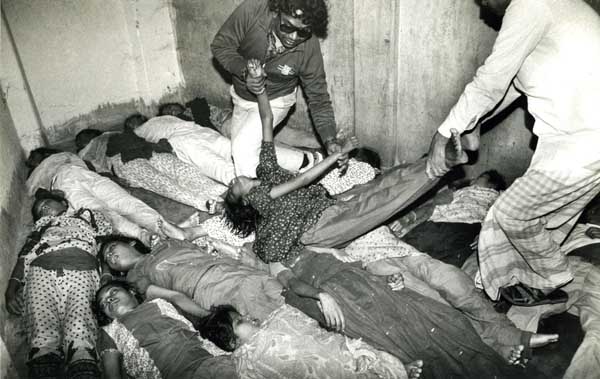Majeda, Jarina, Farida and Many other Garment Workers

By Saydia Gulrukh
Triangle Shirtwaist Factory Fire, New York City, March 25, 1911
Whoever saw the hellish fire at 33 Washington Place,
A terrible tragedy, something quite new,
Can never forget it, And everyone knows many lives were lost.
They were incinerated, In a factory 10 stories high.
There were horrible screams from the onlookers,
Those who were burned alive
And those who choked in the smoke.
(Yehuda Horvitz wrote and sung this song to the tune of a Jewish prayer to commemorate?the deaths of Jewish women in the Triangle Fire)
In many ways, the Triangle Shirtwaist Company was just another sweatshop factory?in the heart of Manhattan. It was located on the top three floors of the ten-story Asch Building just at the end of Washington Square. All that characterizes a sweatshop ? low wages, excessively long hours, and unsanitary and dangerous working conditions ? was part of its factory policy. Most of the several hundred Triangle employees were young women.? Many among them were recently-arrived Italian or Jewish immigrants.
On March 25, 1911, as the hours of the clock approached the closing time, a fire broke out on the top floors of the Asch Building. Flames leapt from discarded rags between the first and second rows of cutting tables.? The fire spread everywhere, as several men continued to fling water at the fire.? In the thickening smoke, a shipping clerk dragged a hose in the stairwell into the rapidly heating room, but nothing came out.? Terrified and screaming girls tried to climb down the narrow fire escape.? Some girls trapped on the ninth floor jumped through the window (Leon Stein, Out of the Sweat Shop, 1977). By the time the fire was over, 146 women garment worker had died. The next two days were marked with the horror and grief of families and comrades desperately trying to identify their dear ones from the bodies burned to bare bones.
In 1909, when women garment workers started to organize and called for a strike demanding better pay, safe working environment, Triangle Shirtwaist was one of the factories which agreed to only a partial settlement. One of the demands that was not met in this settlement was the demand for adequate fire escapes (Meredith Tax, The Uprising Thirty Thousands, 1994). These deaths, horrifyingly cruel, agitated the members of International Ladies Garment Workers Union (ILGWU). Many thousands joined the funeral procession, they mourned the lives lost, and demanded the safety for workers.
Two weeks after the fire, a grand jury indicted Triangle Shirtwaist owners Isaac Harris and Max Blanck on charges of manslaughter. Three years after the fire, on March 11, 1914, twenty-three individual civil suits against the owner of the Asch Building were settled.? The average recovery was $75 per life lost. Calls for justice continued to grow,?thirty-six new laws reforming the state labor code were enacted between 1911 and 1914, those who survived the fire were left to live, and relive, those agonizing moments.
Garib and Garib Sweater Factory, Gazipur, February 25, 2010
21 killed at Garib and Garib Factory, Gazipur, 2010
62 killed at KTS Garments, Chittagong, 2006
23 killed at Shan Knitting, Narayanganj, 2005
23 killed at Chowdhury Knitwear, Narsingdi, 2004
23 killed at Macro Sweater, Dhaka, 2000
12 killed at Globe Knitting, Dhaka, 2000
24 killed at Shanghai Apparels, Dhaka, 1997
20 killed at Jahanara Fashion, Narayanganj, 1997
22 killed at Lusaka Garments, Dhaka, 1996
32 killed at Saraka Garments, Dhaka, 1990
(Source: The Daily Star, March 1, 2010)
It was a little after 9 o?clock at night, workers were finishing their shift. Some were still working, Abdul Mannan of the Garib and Garib factory?s sampling section was among them. He was working on the second floor when he first saw the flame and breathed smoke. It was coming from the first floor. A short circuit had occurred near a large stock of flammable acrylic sweaters, which produced thick and extremely toxic smoke and quickly transformed the factory into a ?gas chamber? (Bdnews24.com, Feb26, 2010). Zarina, Farida, Majeda, Sahara, Majida, Rahima, Shantana, Momtaz, Rasheda, Shahinur, Rawshan, Jahanar, Rina and Sufia were on the sixth floor as the monstrous fire swallowed the building.? The main power was immediately turned off. In the pitch dark, workers, both men and women, ran up stairs to escape, but blazing fires and toxic smoke followed them.

Within half an hour, ambulances and firefighters had circled the building, they started their rescue mission but came across dead bodies only: Kashem, Badal, Alamgir, Mainul and Pradeep, bodies which lay haphazardly in the stairway, there were many others. The events that followed were rather routine. After hours of effort, the fire-fighters tamed the unruly fire.? The Fire Brigade authorities, BGMEA and the government formed three different probe committees to investigate the cause of fire (Daily Star, Feb 27, 2010). In a ?sympathetic? gesture, the authority bore the cost of the burials and kept the factory closed for four days to mourn the deceased workers.? The BGMEA ?expressed sorrow at the death of the workers and announced Tk 2 lakh as compensation for each worker? (New Age, Feb 26, 2010). Labor organizations and left-alliances protested, demanding better compensation, and immediate punishment of those responsible.? They continue to protest, to hold meetings in Muktangon, in Shahid Minar, in Gazipur too, protests which barely manage to prevent us from forgetting about them. Perhaps through taming the fire, the fire-fighters had also tamed the sparks of our anger, anger at the deaths, anger at exploitative and unjust practices in the garments industry.
Collectively Resisting Our Amnesia
The hundred years which separates these two tragedies in the history of the garments industry, incidents that are strikingly similar, also coincides with the international women?s movement which has turned a hundred year’s old. By placing these two stories side by side, I don?t intend to undermine the struggles and achievements of our movement, to argue that ?nothing has changed.? My interest lies in the differences in our response to the two tragedies.
People gathered in thousands to cordon the dead bodies of Triangle factory workers, to hold the hands of hysterically grieving relatives and friends. The ILGWU proposed an official day of mourning. The grief-stricken city gathered in churches, synagogues, and finally, in the streets. In 1911, the funeral procession turned into an ocean of grief as countless numbers of people joined in, while the dead bodies of Zarina, Majeda and Farida were sent in separate ambulances to their village, and the only people who joined in that final journey, besides their family members, were the police. We do not join in their funeral procession in the thousands, we do not take over the street to mourn the lives of these women who had slaved their youth away for the much celebrated, and steady increase in the nation’s GDP. As I read Yehuda Horvitz songs written to commemorate the lives of the women killed in the Triangle fire, I look for songs sung celebrating the lives lost here. What I find is a statistical rhyme, an incomprehensive list of the numbers of workers killed in garments factory fires in the last decade. The thought of garments factories being ?gas-chambers? horrifies us? as long as the news remains fresh, and soon enough, we manage to find ways of returning to the national narrative, working in the garments sector is a stepping stone to women?s empowerment. Images of blazing fires rapidly disappear, stories of Rasheda, Shahinur, Rawshan choking to death are conveniently forgotten. In 1911, many women in the funeral procession in New York city had carried placards which said ?we mourn our loss; we demand real progress in workers protection.? In 2010, we do not mourn our loss. We read of our loss in the newspapers.
There has been much talk of corporate greed and sweatshops, many editorials have been written protesting the criminal indifference of factory owners. Locally and globally, every year thousands of pages are written analyzing the sweatshop economy and the feminization of the global labor force. Perhaps, it’s time to analyze our deadly indifference. On international women?s day, a true tribute to Rahima, Shantana, Momtaz and many other sisters whose names will soon be lost in the statistical crowd, can be offered by resisting our own collective amnesia.
Saydia Gulrukh is a PhD student at the University of North Carolina – Chapel Hill, USA
and a faculty member of Pathshala, The South Asian Media Academy
Published in New Age, 8 March 2010
